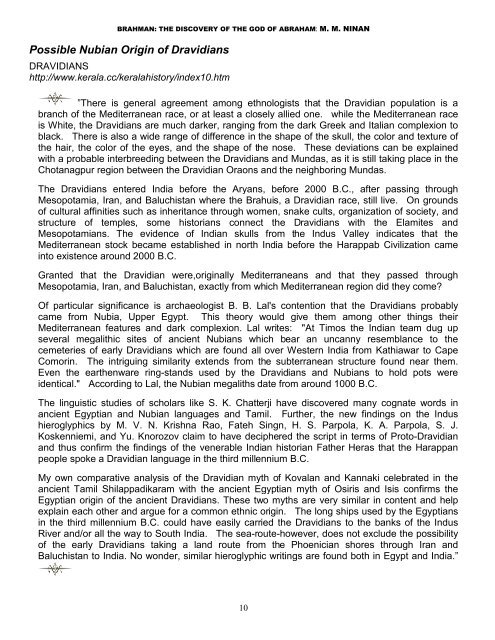Create successful ePaper yourself
Turn your PDF publications into a flip-book with our unique Google optimized e-Paper software.
BRAHMAN: THE DISCOVERY OF THE GOD OF ABRAHAM: M. M. NINAN<br />
Possible Nubian Origin of Dravidians<br />
DRAVIDIANS<br />
http://www.kerala.cc/keralahistory/index10.htm<br />
”There is general agreement among ethnologists that the Dravidian population is a<br />
branch of the Mediterranean race, or at least a closely allied one. while the Mediterranean race<br />
is White, the Dravidians are much darker, ranging from the dark Greek and Italian complexion to<br />
black. There is also a wide range of difference in the shape of the skull, the color and texture of<br />
the hair, the color of the eyes, and the shape of the nose. These deviations can be explained<br />
with a probable interbreeding between the Dravidians and Mundas, as it is still taking place in the<br />
Chotanagpur region between the Dravidian Oraons and the neighboring Mundas.<br />
The Dravidians entered India before the Aryans, before 2000 B.C., after passing through<br />
Mesopotamia, Iran, and Baluchistan where the Brahuis, a Dravidian race, still live. On grounds<br />
of cultural affinities such as inheritance through women, snake cults, organization of society, and<br />
structure of temples, some historians connect the Dravidians with the Elamites and<br />
Mesopotamians. The evidence of Indian skulls from the Indus Valley indicates that the<br />
Mediterranean stock became established in north India before the Harappab Civilization came<br />
into existence around 2000 B.C.<br />
Granted that the Dravidian were,originally Mediterraneans and that they passed through<br />
Mesopotamia, Iran, and Baluchistan, exactly from which Mediterranean region did they come?<br />
Of particular significance is archaeologist B. B. Lal's contention that the Dravidians probably<br />
came from Nubia, Upper Egypt. This theory would give them among other things their<br />
Mediterranean features and dark complexion. Lal writes: "At Timos the Indian team dug up<br />
several megalithic sites of ancient Nubians which bear an uncanny resemblance to the<br />
cemeteries of early Dravidians which are found all over Western India from Kathiawar to Cape<br />
Comorin. The intriguing similarity extends from the subterranean structure found near them.<br />
Even the earthenware ring-stands used by the Dravidians and Nubians to hold pots were<br />
identical." According to Lal, the Nubian megaliths date from around 1000 B.C.<br />
The linguistic studies of scholars like S. K. Chatterji have discovered many cognate words in<br />
ancient Egyptian and Nubian languages and Tamil. Further, the new findings on the Indus<br />
hieroglyphics by M. V. N. Krishna Rao, Fateh Singn, H. S. Parpola, K. A. Parpola, S. J.<br />
Koskenniemi, and Yu. Knorozov claim to have deciphered the script in terms of Proto-Dravidian<br />
and thus confirm the findings of the venerable Indian historian Father Heras that the Harappan<br />
people spoke a Dravidian language in the third millennium B.C.<br />
My own comparative analysis of the Dravidian myth of Kovalan and Kannaki celebrated in the<br />
ancient Tamil Shilappadikaram with the ancient Egyptian myth of Osiris and Isis confirms the<br />
Egyptian origin of the ancient Dravidians. These two myths are very similar in content and help<br />
explain each other and argue for a common ethnic origin. The long ships used by the Egyptians<br />
in the third millennium B.C. could have easily carried the Dravidians to the banks of the Indus<br />
River and/or all the way to South India. The sea-route-however, does not exclude the possibility<br />
of the early Dravidians taking a land route from the Phoenician shores through Iran and<br />
Baluchistan to India. No wonder, similar hieroglyphic writings are found both in Egypt and India.”<br />
10


















